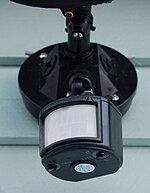Seminar on Motion detector
An electronic motion detector contains a motion sensor that transforms the detection of motion into an electric signal. This can be achieved by measuring optical or acoustical changes in the field of view. Most motion detectors can detect up to 15–25 meters (50–80 feet).
A motion detector may be connected to a burglar alarm that is used to alert the home owner or security service after it detects motion. Such a detector may also trigger a red light camera or outdoor lighting.
An occupancy sensor is a motion detector that is integrated with a timing device. It senses when motion has stopped for a specified time period in order to trigger a light extinguishing signal. These devices prevent illumination of unoccupied spaces like public toilets. They are widely used for security purposes.a

There are basically four types of sensors used in motion detectors spectrum:
Passive infrared sensors (Passive)
Looks for body heat. No energy is emitted from the sensor.
Ultrasonic (active)
Sends out pulses of ultrasonic waves and measures the reflection off a moving object.
Microwave (active)
Sensor sends out microwave pulses and measures the reflection off a moving object. Similar to a police radar gun.
Tomographic Detector (active)
Senses disturbances to radio waves as they travel through an area surrounded by mesh network nodes.
Presentation on Motion sensor


1 comments:
Which of the four types is most efficient in detecting movement? I used to have a passive IR device and it didn't really do a good job and were often ineffective (i.e. it didn't detect movement about 40% of the time).
Post a Comment